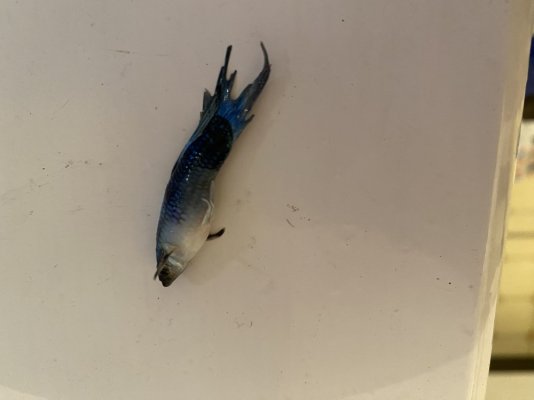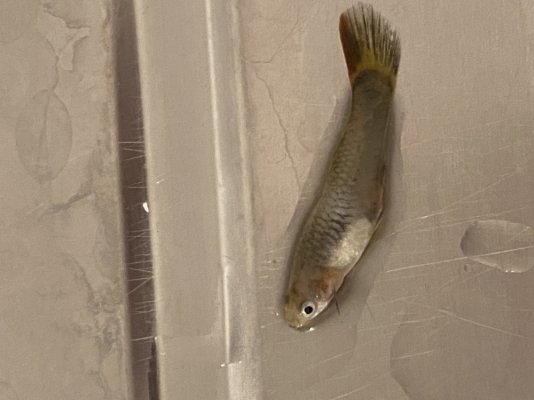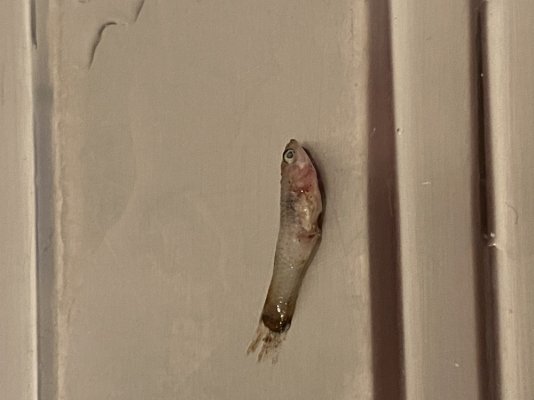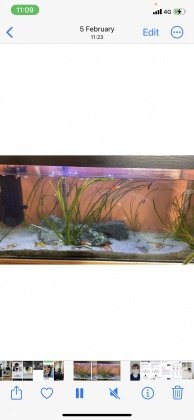Hi, I currently have 2 aquariums a large 3ft one and a smaller 18inch one. I’ve had my guppies for nearly 2 years they were doing well all healthy with lovely colours, I originally set up the smaller tank for the female guppies, as they were getting hounded by the males in the large tank. But just over a week ago I started seeing at least one guppy a day dead in the large tank, there was a female still in the large tank and I recently moved her to the small tank, two days later I started seeing the females staying still at the bottom of the aquarium, and one by one they have died, I’ve found another two dead this morning. Do I have some sort of bacterial infection in the tanks? Im unsure what to do! Any advice would be greatly appreciated.
You are using an out of date browser. It may not display this or other websites correctly.
You should upgrade or use an alternative browser.
You should upgrade or use an alternative browser.
Help my guppies are dying
- Thread starter lisa73
- Start date
The friendliest place on the web for anyone with an interest in aquariums or fish keeping!
If you have answers, please help by responding to the unanswered posts.
If you have answers, please help by responding to the unanswered posts.
Please take a read through the "unhealthy fish" sticky and answer the questions as fully as you are able. A clear, in focus photo will help too.
https://www.aquariumadvice.com/forums/f17/before-posting-about-unhealthy-fish-read-this-32451.html
A couple of years would be the expected lifespan of guppies though.
https://www.aquariumadvice.com/forums/f17/before-posting-about-unhealthy-fish-read-this-32451.html
A couple of years would be the expected lifespan of guppies though.
Colin_T
Aquarium Advice Addict
Post pictures of any dead fish and the remaining live fish so we can check them for diseases.
Have you added anything to the tank in the 2 weeks before this started?
What is the ammonia, nitrite, nitrate and pH of the water?
What sort of filter is on the tank?
How often and how do you clean the filter?
How often do you do water changes and how much do you change?
Do you gravel clean the substrate when you do a water change?
Do you dechlorinate the new water before adding it to the aquarium?
----------------------
BASIC FIRST AID FOR FISH
Test the water for ammonia, nitrite, nitrate and pH. Post the results in numbers here.
Wipe the inside of the glass down with a clean fish sponge. This removes the biofilm on the glass and the biofilm will contain lots of harmful bacteria, fungus, protozoans and various other microscopic life forms.
Do a 75% water change and gravel clean the substrate every day for a week or until the problem is identified. The water changes and gravel cleaning will reduce the number of disease organisms in the water and provide a cleaner environment for the fish to recover in. It also removes a lot of the gunk and this means any medication can work on treating the fish instead of being wasted killing the pathogens in the gunk.
Make sure any new water is free of chlorine/ chloramine before it is added to the tank.
Clean the filter if it hasn't been done in the last 2 weeks. However, if the filter is less than 6 weeks old, do not clean it. Wash the filter materials/ media in a bucket of tank water and re-use the media. Tip the bucket of dirty water on the garden/ lawn. Cleaning the filter means less gunk and cleaner water with fewer pathogens so any medication (if needed) will work more effectively on the fish.
Increase surface turbulence/ aeration to maximise the dissolved oxygen in the water.
Post clear pictures of the fish so we can check them for diseases.
Have you added anything to the tank in the 2 weeks before this started?
What is the ammonia, nitrite, nitrate and pH of the water?
What sort of filter is on the tank?
How often and how do you clean the filter?
How often do you do water changes and how much do you change?
Do you gravel clean the substrate when you do a water change?
Do you dechlorinate the new water before adding it to the aquarium?
----------------------
BASIC FIRST AID FOR FISH
Test the water for ammonia, nitrite, nitrate and pH. Post the results in numbers here.
Wipe the inside of the glass down with a clean fish sponge. This removes the biofilm on the glass and the biofilm will contain lots of harmful bacteria, fungus, protozoans and various other microscopic life forms.
Do a 75% water change and gravel clean the substrate every day for a week or until the problem is identified. The water changes and gravel cleaning will reduce the number of disease organisms in the water and provide a cleaner environment for the fish to recover in. It also removes a lot of the gunk and this means any medication can work on treating the fish instead of being wasted killing the pathogens in the gunk.
Make sure any new water is free of chlorine/ chloramine before it is added to the tank.
Clean the filter if it hasn't been done in the last 2 weeks. However, if the filter is less than 6 weeks old, do not clean it. Wash the filter materials/ media in a bucket of tank water and re-use the media. Tip the bucket of dirty water on the garden/ lawn. Cleaning the filter means less gunk and cleaner water with fewer pathogens so any medication (if needed) will work more effectively on the fish.
Increase surface turbulence/ aeration to maximise the dissolved oxygen in the water.
Post clear pictures of the fish so we can check them for diseases.
Hi, thank you for responding,
I haven’t added anything to the tank in the last 2 weeks.
I’ve checked the ammonia, nitrite, nitrate and Ph levels, the only issue there is the HP level is slightly high but other than that all are fine.
I clean the filter every Sunday it’s a fluval 3 filter.
I did a 50% water change on Sunday and cleaned the substrate and removed some of the plants as I found a few of the dead fish tangled in the foliage.
When I’m home later I will upload a pic of the tank and 2 of the dead fish.
I haven’t added anything to the tank in the last 2 weeks.
I’ve checked the ammonia, nitrite, nitrate and Ph levels, the only issue there is the HP level is slightly high but other than that all are fine.
I clean the filter every Sunday it’s a fluval 3 filter.
I did a 50% water change on Sunday and cleaned the substrate and removed some of the plants as I found a few of the dead fish tangled in the foliage.
When I’m home later I will upload a pic of the tank and 2 of the dead fish.
Can you post actual numbers for your water parameters rather then "all are fine". Preferably before a water change.
Colin_T
Aquarium Advice Addict
I clean the filter every Sunday it’s a fluval 3 filter.
I did a 50% water change on Sunday and cleaned the substrate and removed some of the plants as I found a few of the dead fish tangled in the foliage.
How do you clean the filter?
Do you do a 50% water change and gravel clean the substrate every week?
Do you dechlorinate the new tap water before adding it to the aquarium?
Hi sorry for the long delay in replying, I was at work.
When I get home I will do a water test for exact figures on the water condition .
I think the HP level is a little low.
I will do another large water change too and clean the filter. I usually do a 40% water change weekly when cleaning the filter, I use the water from the aquarium to clean the filter sponges. And treat the tap water before adding it to the tank.
When I get home I will do a water test for exact figures on the water condition .
I think the HP level is a little low.
I will do another large water change too and clean the filter. I usually do a 40% water change weekly when cleaning the filter, I use the water from the aquarium to clean the filter sponges. And treat the tap water before adding it to the tank.
Hi further to your request I have my reading for the water quality in both aquariums.
Small aquarium reads:
Nitrate 4.0
Nitrite 1
PH 6.5
KH carbonate hardness 0
GH general hardness 120
Large aquarium reads:
Nitrate 4.0
Nitrite. 0.5
PH 7.0
KH carbonate hardness 40
GH general hardness 180
Small aquarium reads:
Nitrate 4.0
Nitrite 1
PH 6.5
KH carbonate hardness 0
GH general hardness 120
Large aquarium reads:
Nitrate 4.0
Nitrite. 0.5
PH 7.0
KH carbonate hardness 40
GH general hardness 180
Im guessing you are using test strips. Test strips dont have the ammonia on them, and that is the most likely parameter to be off. You need to get a test kit that covers pH, ammonia, nitrite and nitrate. Preferably a liquid test kit. API Freshwater Master Test Kit is a good one to go for. It covers what you need, is more accurate than strips, and although more expensive up front, it will be more cost effective long run than strips as you get 100s of tests from it.
From the information you have provided you have a water quality issue. Something has crashed your cycle. Your nitrite in the 2nd tank is at hazardous levels and in the first tank its getting there. As you have lost your cycle you are likely to have elevated ammonia too.
Change 50% of the water on each tank as soon as you are able. And until you are able to test for ammonia change 30 to 50% of the water daily. Once you can test you work towards getting your tanks recycled.
Its odd that both tanks lost their cycle at the same time. Have you done any tank maintenance recently like a gravel vac, or filter maintenance or changing a filter cartridge?
From the information you have provided you have a water quality issue. Something has crashed your cycle. Your nitrite in the 2nd tank is at hazardous levels and in the first tank its getting there. As you have lost your cycle you are likely to have elevated ammonia too.
Change 50% of the water on each tank as soon as you are able. And until you are able to test for ammonia change 30 to 50% of the water daily. Once you can test you work towards getting your tanks recycled.
Its odd that both tanks lost their cycle at the same time. Have you done any tank maintenance recently like a gravel vac, or filter maintenance or changing a filter cartridge?
Always get numbers. Don't trust fish stores when they just say its OK. You have no idea what they consider to be OK. You yourself said your water tests where OK and they arent. This is why numbers are important.
You still need to cycle the tanks again and that means daily testing so i would still get that test kit and change water daily until you can test your own water.
You still need to cycle the tanks again and that means daily testing so i would still get that test kit and change water daily until you can test your own water.
Last edited:
Yes I was disappointed that they didn’t give me any figures for the ammonia.
I have done a water change on both tanks this evening and treated the tap water, I washed the filter sponges with the water out of each aquarium. Should I add any PH treatment?
I have done a water change on both tanks this evening and treated the tap water, I washed the filter sponges with the water out of each aquarium. Should I add any PH treatment?
Steady pH is more important than trying to attain what you think is ideal. Fish are adaptable to varying pH levels, but they don't like rapidly changing pH levels which you get if you try and add chemicals to change the pH.
It will be the nitrite causing your issues and maybe ammonia as we don't know about that. Guppies do like a pH 7+ but trying to force it will cause more problems than it solves.
You could get some crushed coral, put it in a media bag and put that in your filter. Or get a piece of cuttlefish bone and drop it somewhere in your tanks. These are calcium carbonate which will slowly disolve and gradually increase pH, KH and GH without stressing fish.
Might be worthwhile doing a set of tests on your tap water. Leave tap water in a jug overnight before testing to give disolved gases chance to balance out so its comparable conditions with water in your tank.
It will be the nitrite causing your issues and maybe ammonia as we don't know about that. Guppies do like a pH 7+ but trying to force it will cause more problems than it solves.
You could get some crushed coral, put it in a media bag and put that in your filter. Or get a piece of cuttlefish bone and drop it somewhere in your tanks. These are calcium carbonate which will slowly disolve and gradually increase pH, KH and GH without stressing fish.
Might be worthwhile doing a set of tests on your tap water. Leave tap water in a jug overnight before testing to give disolved gases chance to balance out so its comparable conditions with water in your tank.
Colin_T
Aquarium Advice Addict
The dead fish in the pictures appear to have an external bacterial and maybe protozoan infection.
The first picture (blue male guppy) appears to have excess mucous around the lower half of the body behind the belly. This could be protozoan.
Second picture is a female that has a cream patch on her back as well as a bit of cream colour in the muscle tissue. The patch on the back is either bacterial or protozoan. If she has cream colour muscle tissue in the rear half of the body that is usually a microsporidian infection.
Third picture is a badly chewed up fish, possibly female and has red marks and white patches and that is bacterial.
------------------
If you can post pictures of the remaining live fish, I will check them and see if I can confirm protozoan or bacterial. In the mean time, add some salt. It will treat minor bacterial infections, a number of external protozoan infections, and microsporidian infections.
------------------
SALT
You can add rock salt (often sold as aquarium salt), swimming pool salt, or any non iodised salt (sodium chloride) to the aquarium at the dose rate of 1 heaped tablespoon per 20 litres of water. If there is no improvement after 48 hours you can double that dose rate so there is 2 heaped tablespoons of salt per 20 litres.
If you only have livebearers (guppies, platies, swordtails, mollies), goldfish or rainbowfish in the tank you can double that dose rate, so you would add 2 heaped tablespoons per 20 litres and if there is no improvement after 48 hours, then increase it so there is a total of 4 heaped tablespoons of salt per 20 litres.
Keep the salt level like this for at least 2 weeks but no longer than 4 weeks otherwise kidney damage can occur. Kidney damage is more likely to occur in fish from soft water (tetras, Corydoras, angelfish, Bettas & gouramis, loaches) that are exposed to high levels of salt for an extended period of time, and is not an issue with livebearers, rainbowfish or other salt tolerant species.
The salt will not affect the beneficial filter bacteria but the higher dose rate (4 heaped tablespoons per 20 litres) will affect some plants and some snails. The lower dose rate (1-2 heaped tablespoons per 20 litres) will not affect fish, plants, shrimp or snails.
After you use salt and the fish have recovered, you do a 10% water change each day for a week using only fresh water that has been dechlorinated. Then do a 20% water change each day for a week. Then you can do bigger water changes after that. This dilutes the salt out of the tank slowly so it doesn't harm the fish.
If you do water changes while using salt, you need to treat the new water with salt before adding it to the tank. This will keep the salt level stable in the tank and minimise stress on the fish.
When you first add salt, add the salt to a small bucket of tank water and dissolve the salt. Then slowly pour the salt water into the tank near the filter outlet. Add the salt over a couple of minutes.
The first picture (blue male guppy) appears to have excess mucous around the lower half of the body behind the belly. This could be protozoan.
Second picture is a female that has a cream patch on her back as well as a bit of cream colour in the muscle tissue. The patch on the back is either bacterial or protozoan. If she has cream colour muscle tissue in the rear half of the body that is usually a microsporidian infection.
Third picture is a badly chewed up fish, possibly female and has red marks and white patches and that is bacterial.
------------------
If you can post pictures of the remaining live fish, I will check them and see if I can confirm protozoan or bacterial. In the mean time, add some salt. It will treat minor bacterial infections, a number of external protozoan infections, and microsporidian infections.
------------------
SALT
You can add rock salt (often sold as aquarium salt), swimming pool salt, or any non iodised salt (sodium chloride) to the aquarium at the dose rate of 1 heaped tablespoon per 20 litres of water. If there is no improvement after 48 hours you can double that dose rate so there is 2 heaped tablespoons of salt per 20 litres.
If you only have livebearers (guppies, platies, swordtails, mollies), goldfish or rainbowfish in the tank you can double that dose rate, so you would add 2 heaped tablespoons per 20 litres and if there is no improvement after 48 hours, then increase it so there is a total of 4 heaped tablespoons of salt per 20 litres.
Keep the salt level like this for at least 2 weeks but no longer than 4 weeks otherwise kidney damage can occur. Kidney damage is more likely to occur in fish from soft water (tetras, Corydoras, angelfish, Bettas & gouramis, loaches) that are exposed to high levels of salt for an extended period of time, and is not an issue with livebearers, rainbowfish or other salt tolerant species.
The salt will not affect the beneficial filter bacteria but the higher dose rate (4 heaped tablespoons per 20 litres) will affect some plants and some snails. The lower dose rate (1-2 heaped tablespoons per 20 litres) will not affect fish, plants, shrimp or snails.
After you use salt and the fish have recovered, you do a 10% water change each day for a week using only fresh water that has been dechlorinated. Then do a 20% water change each day for a week. Then you can do bigger water changes after that. This dilutes the salt out of the tank slowly so it doesn't harm the fish.
If you do water changes while using salt, you need to treat the new water with salt before adding it to the tank. This will keep the salt level stable in the tank and minimise stress on the fish.
When you first add salt, add the salt to a small bucket of tank water and dissolve the salt. Then slowly pour the salt water into the tank near the filter outlet. Add the salt over a couple of minutes.
Similar threads
- Replies
- 14
- Views
- 511
- Replies
- 2
- Views
- 405
- Replies
- 1
- Views
- 384
- Replies
- 1
- Views
- 335




